Calculation Method of New Assembled Corrugated Steel Initial Support Structure of Highway Tunnel
Abstract
:1. Introduction
2. Full-Scale Test of Corrugated Steel
2.1. Full-Scale Test
2.1.1. Specimen Design
2.1.2. Test Apparatus and Loading Procedure
2.1.3. Measuring System
2.2. Test Results and Analysis
2.2.1. Test Results
2.2.2. Comparative Analysis between Test and Simulation
2.3. Equivalent Stiffness Coefficient
2.3.1. Proposal of Equivalent Stiffness Coefficient
2.3.2. Analysis of Influence Factors
3. Rotational Stiffness of Corrugated Steel Flange Joint
3.1. Fine Numerical Simulation Analysis
3.2. Results and Analysis
3.3. Rotational Stiffness of Joint
3.3.1. Rotational Angle of CSFJ
3.3.2. Rotational Stiffness of CSFJ
3.4. Plane Strain-Spring Simplified Model and Its Validation
4. Practical Engineering Application
4.1. Project Overview
4.2. Numerical Simulation
4.2.1. Model Parameter
- (1)
- Surrounding rock: The tunnel is buried at a depth of 50 m, with a height from the lower boundary to the tunnel floor bottom being five times the tunnel height, and the span from the left and right boundaries to the tunnel wall is five times the tunnel span. The surrounding rock is classified as grade IV. Geological survey data provide mechanical parameters for the surrounding rock in each stratum, as detailed in Table 3.
- (2)
- CSP: The model is 380 mm × 140 mm × 5 mm. According to Equation (11), it is calculated that heq = 157 mm and beq = 41 mm. In addition, the parameters of the rotational connector are entered according to Table 4.
- (3)
- Backside shotcrete of CSP: the concrete grade is C20, the modulus of elasticity is E = 2.55 × 104 MPa, the critical yield stress is σy = 9.6 MPa, and the thickness is 5 cm.
- (4)
- Secondary lining concrete: the concrete grade is C30, the modulus of elasticity is E = 3.0 × 104 MPa, and the thickness is 35 cm.
- (5)
- Anchor bolt: The angle of depression of the anchor bolt is 15°, which is located at the arch foot and the arch waist; the actual diameter of the anchor bolt is 42 mm, and the spacing between the anchor bolts is 0.38 m × 4 = 1.52 m. After conversion, the diameter of the anchor bolt per linear meter is 38 mm.
4.2.2. Structural Contact
4.3. Comparative Analysis of Monitoring Data
4.3.1. CSP Strain
4.3.2. Convergence around the Tunnel
4.3.3. Discussion on the Simplified Calculation Methods
5. Conclusions
- (1)
- Full-scale tests were performed to characterize the stiffness properties of the CSP plate’s load–deformation curve in two stages: clearance elimination and elastic stages. The presence of initial gaps within the structure and loading system was found to initiate the clearance elimination stage. To refine the calculated CSP stiffness values, a general equivalent stiffness coefficient table for CSP plates was established, and its variation pattern was analyzed: the equivalent stiffness coefficient decreases with increasing relative displacement between plates (RDP). When the RDP exceeds 0.333, the equivalent stiffness coefficient positively correlates with thickness; otherwise, it exhibits a negative correlation.
- (2)
- The entire loading process of the CSFJ was generalized into a rotational stiffness model encompassing two stages: elastic and plastic. Both stages demonstrated linear behavior. Based on the rotational stiffness values from these stages, a plane strain-spring simplified model for the assembled corrugated steel initial support structure, accounting for joint conditions, was proposed.
- (3)
- Leveraging the Qipanshan Tunnel in Yunnan Province, a numerical model of the assembled corrugated steel initial support structure was established, incorporating structural contact relationships and constitutive models. A comparative analysis of calculation results and monitoring data was conducted to validate the accuracy and reliability of the calculation mentioned in the above method.
Author Contributions
Funding
Institutional Review Board Statement
Informed Consent Statement
Data Availability Statement
Conflicts of Interest
References
- Wu, M.; Wu, Q. Present Situation and Prospect of Mechanization Construction of Mountain Highway Tunnels. J. Chongqing Jiaotong Univ. (Nat. Sci.) 2020, 39, 14–21. [Google Scholar]
- Song, D. Study on the Mechanical Mechanism of Shotcrete-rockbolt Support System. Chin. J. Rock Mech. Eng. 1991, 2, 197–204. [Google Scholar]
- Bratschi, O. The railway equipment of the Gotthard base tunnel. ZEV Rail Glasers Annalen. 2008, 132, 447–450. [Google Scholar]
- Lunardi, P. Design and Construction of Tunnels; Springer: Berlin/Heidelberg, Germany, 2017. [Google Scholar]
- Lade, R.W.; Benjamin, J.A.; Schutten, H.P. Method for Making Vertically Layered MOMOM Tunnel Device. U.S. Patent 4,675,980, 30 June 1987. [Google Scholar]
- Li, G.; Ding, W.Q.; Ye, H. Study on the Construction Technology of Corrugated Steel Prefabricated Support Structure in Tunnel. Chin. J. Undergr. Space Eng. 2020, 16 (Suppl. S1), 178–184. [Google Scholar] [CrossRef]
- Liu, W.; Wang, X.; Jiang, H.; Ding, W.; Zhang, Q. Monitoring and numerical simulation analysis of corrugated steel support in weak surrounding rock mountain tunnels. IOP Conf. Ser. Mater. Sci. Eng. 2020, 741, 012042. [Google Scholar] [CrossRef]
- Li, H.J.; Wu, H.X.; Wang, Z.; Zhang, G.K.; Li, J.; Zhou, H.; Wang, M.Y.; He, Y. Experimental and numerical simulation of the propagation law of shock waves in corrugated steel-lined tunnels. Process Saf. Environ. Prot. 2022, 168, 1019–1030. [Google Scholar] [CrossRef]
- Ding, W.Q.; Huang, X.B.; Li, S.B.; Liu, W.T.; Zhang, Q.Z. Flexural stiffness characterization of the corrugated steel–concrete composite structure for tunnel projects. Undergr. Space 2023, 12, 18–30. [Google Scholar] [CrossRef]
- Zhao, G.Q.; Liu, J.T.; Meng, S.Y.; Liu, C.Y.; Wang, Q.H. Performance of corrugated steel plate flange joint under combined compression and Bending: Experimental and numerical investigations. Constr. Build. Mater. 2023, 389, 131798. [Google Scholar] [CrossRef]
- Yeau, K.Y.; Sezen, H.; Fox, P.J. Load Performance of In Situ Corrugated Steel Highway Culverts. J. Perform. Constr. Facil. 2009, 23, 32–39. [Google Scholar] [CrossRef]
- García, D.B.; Moore, I.D. The performance of deteriorated corrugated steel culverts was rehabilitated with sprayed-on cementitious liners subjected to surface loads. Tunn. Undergr. Space Technol. Inc. Trenchless Technol. Res. 2015, 47, 222–232. [Google Scholar] [CrossRef]
- Dai, M.; Guo, H.; Cai, J.; Lei, D. Static Analysis of Long-span Bridge Culvert in Corrugated Sheet Steel. Subgrade Eng. 2017, 5, 179–182. [Google Scholar]
- AASHTO. Standard Specifications for Highway Bridges, in Design; AASHTO: Washington, DC, USA, 1931. [Google Scholar]
- AS/NZS 2041.2:2011; Buried Corrugated Metal Structures—Installation, in Design. Standards Australia: Sydney, Australia, 1998.
- Xu, P.F.; Wei, Y.J.; Yang, Y.Y.; Zhou, X. Application of fabricated corrugated steel plate in subway tunnel supporting structure. Case Stud. Constr. Mater. 2022, 17, e01323. [Google Scholar] [CrossRef]
- Kunecki, B. Field Test and Three-Dimensional Numerical Analysis of Soil-Steel Tunnel During Backfilling. Transp. Res. Rec. 2014, 2462, 55–60. [Google Scholar] [CrossRef]
- He, W.T.; Liu, B.D.; Han, G.; Sun, S.W. Research of corrugated steel plate and concrete composite structure in bridge reinforcement and reconstruction. Earthq. Resist. Eng. Retrofit. 2019, 41, 104–111. [Google Scholar]
- Beben, D. Field Performance of Corrugated Steel Plate Road Culvert under Normal Live-Load Conditions. J. Perform. Constr. Facil. 2013, 27, 807–817. [Google Scholar] [CrossRef]
- Peng, S.Q.; Fan, L.; Jiang, C.R.; Zhou, J. Calculation and sensitivity analysis of corrugated steel bridge and culvert structure. J. Tongji Univ. 2005, 33, 1571–1575. [Google Scholar]
- Yu, C.S.; Ding, W.Q.; Wu, T.X.; Zhang, Q.Z. Study on calculation method of new corrugated steel reinforcement structure of highway tunnel. IOP Conf. Ser. Mater. Sci. Eng. 2020, 741, 012073. [Google Scholar] [CrossRef]
- ISO 630-1:2011(E); Structural Steels Part 1: General Technical Delivery Conditions for Hot-rolled Products. ISO: Geneva, Switzerland, 2011.
- Ding, W.Q.; Guo, Y.J.; Li, S.B.; Li, X.R.; Zhang, Q.Z. Experimental research on the mechanical behavior of segmental joints of shield tunnel reinforced with a new stainless steel corrugated plate. Case Stud. Constr. Mater. 2023, 18, e02170. [Google Scholar] [CrossRef]
- DB42/T 1195—2016; Manual for Design and Construction of Corrugated Steel Buried Structures. 2014: Manual for Design and Construction of Corrugated Steel Buried Structures. Hubei Quality and Technical Supervision Bureau: Wuhan, China, 2016.
- You, Q.; Miao, L.; Dong, D. Analysis on mechanical property of corrugated steel pipes. J. Southeast Univ. Nat. Sci. Ed. 2017, 47, 1187–1194. [Google Scholar]
- Huang, M.L.; Sun, T.; Zhang, Y.Q.; Song, Y. Experimental Research on Mechanical Properties of Corrugated Steel Primary Supported Structure Joint Type. Tunn. Constr. 2021, 41 (Suppl. S2), 43–49. [Google Scholar]
- Ding, W.Q.; Chen, X.Q.; Jin, Y.L.; Qiao, Y.F. Flexural behavior of segmental joint containing double rows of bolts: Experiment and simulation. Tunn. Undergr. Space Technol. 2021, 112, 103940. [Google Scholar] [CrossRef]
- Su, Q.T.; Du, X.; Li, C.X.; Jiang, X. Tests of Basic Physical Parameters of Steel-concrete Interface. J. Tongji Univ. Nat. Sci. 2016, 44, 499–506. [Google Scholar]
- Wang, J.C.; Huang, W.M.; Xu, R.Q.; Yang, Z.; Xu, R. Analytical Solution for Segmental-Tunnel Lining Incorporating Interaction between Adjacent Rings. J. Eng. Mech. 2020, 146, 04020075. [Google Scholar] [CrossRef]
- Mirparizi, M.; Fotuhi, A.R. Nonlinear coupled thermo-hyperelasticity analysis of thermal and mechanical wave propagation in a finite domain. Phys. A Stat. Mech. Its Appl. 2019, 537, 122755. [Google Scholar] [CrossRef]
- Mirparizi, M.; Fotuhi, A.R.; Shariyat, M. Nonlinear coupled thermoelastic analysis of thermal wave propagation in a functionally graded finite solid undergoing finite strain. J. Therm. Anal. Calorim. 2020, 139, 2309–2320. [Google Scholar] [CrossRef]
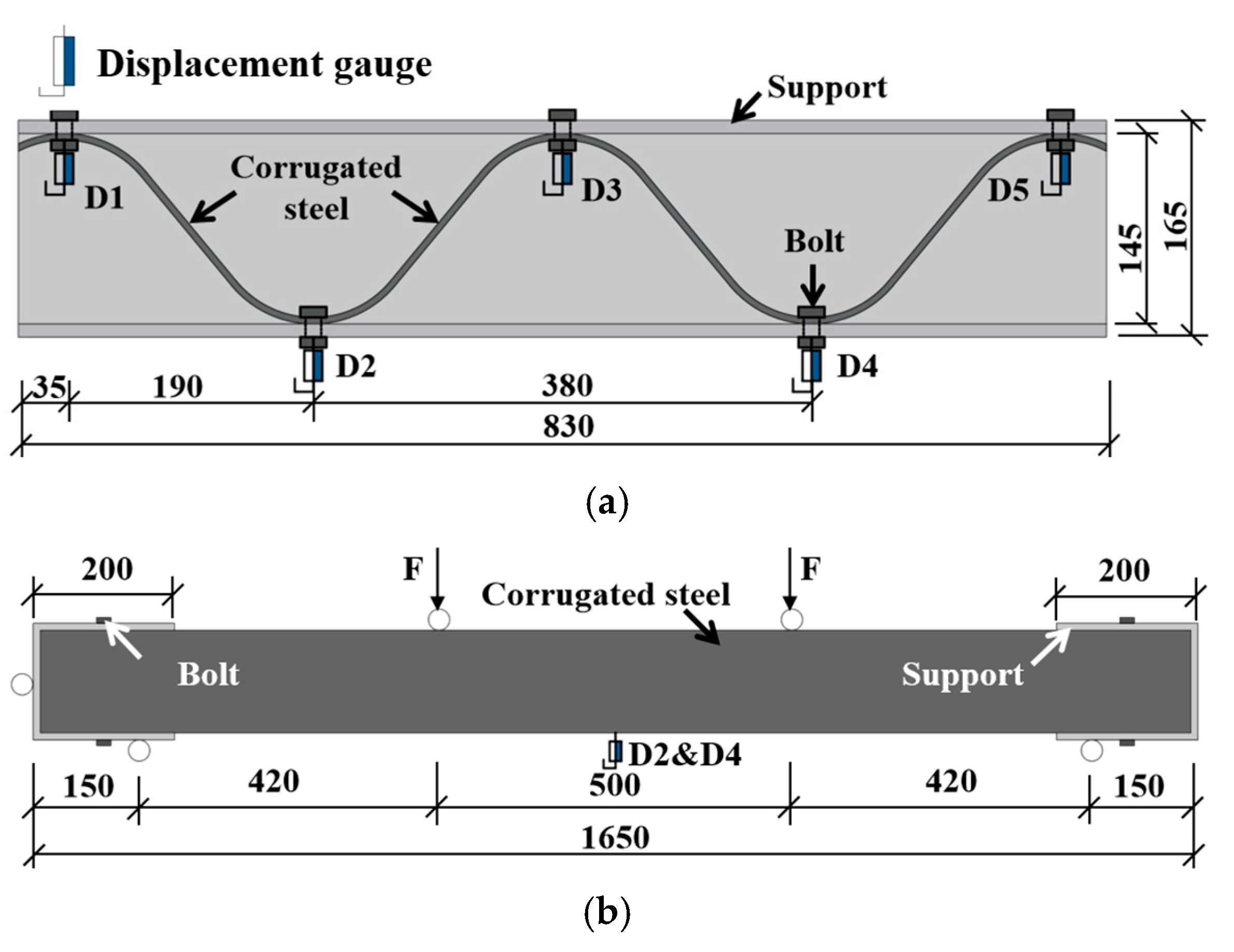

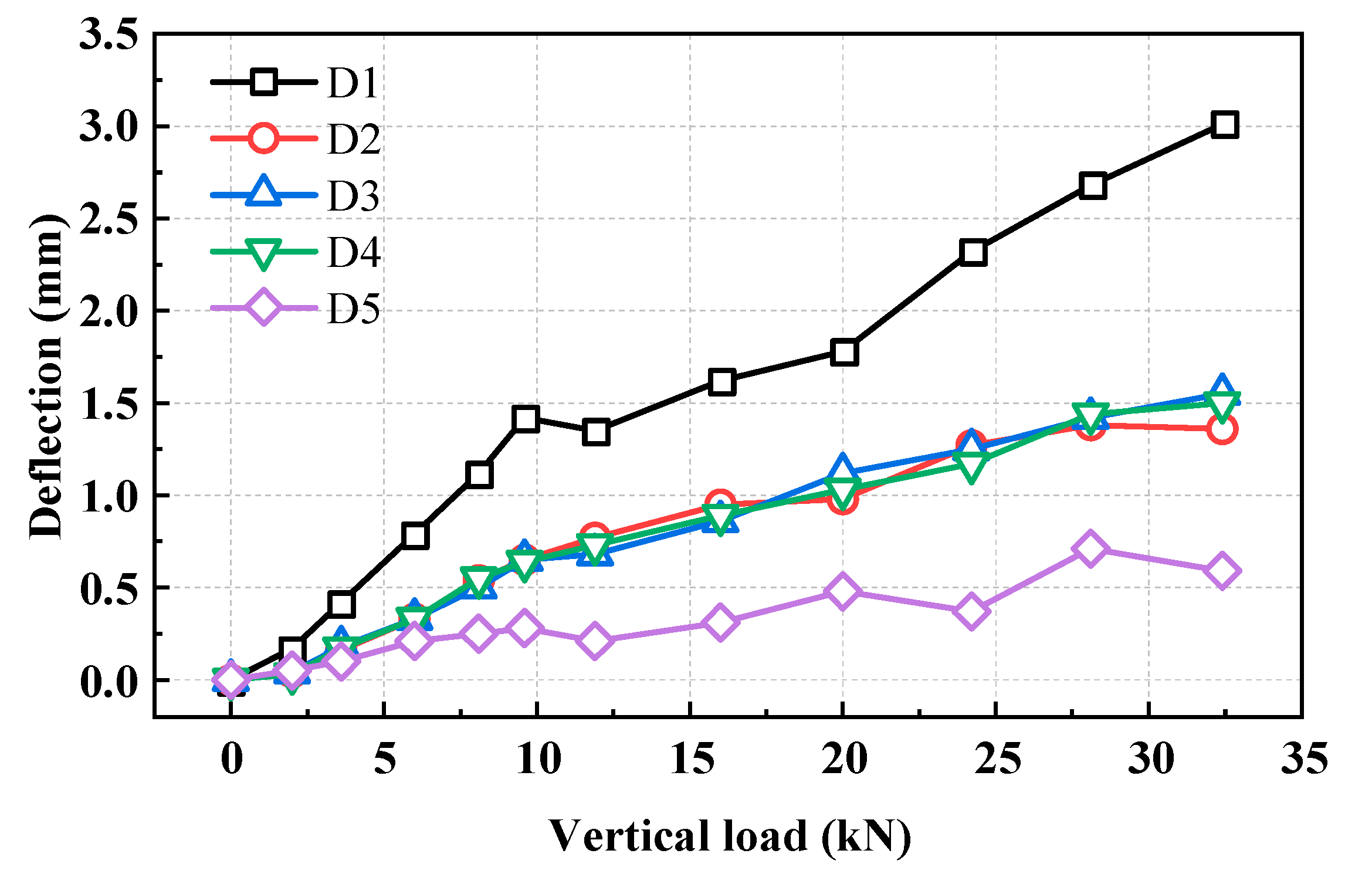
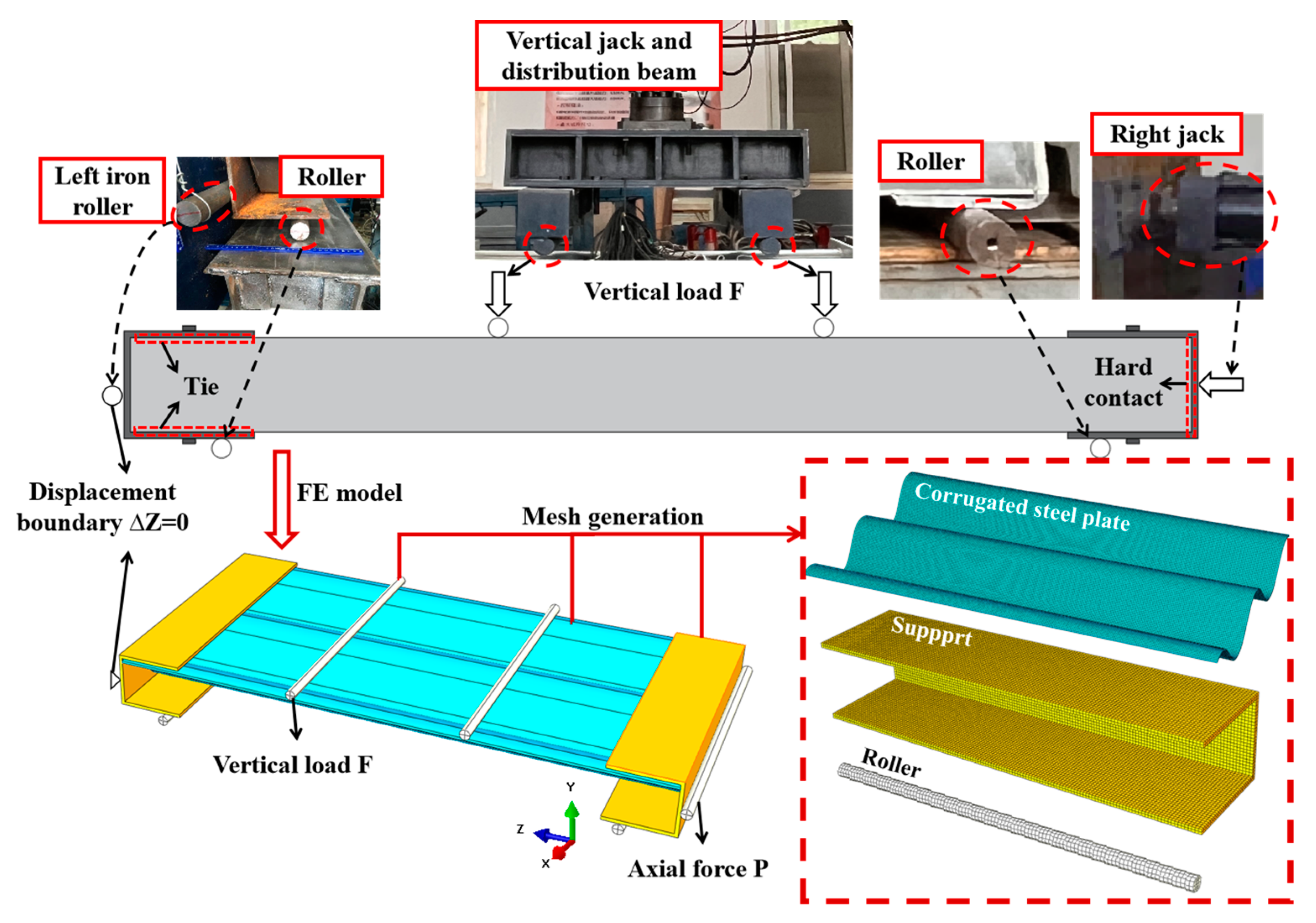
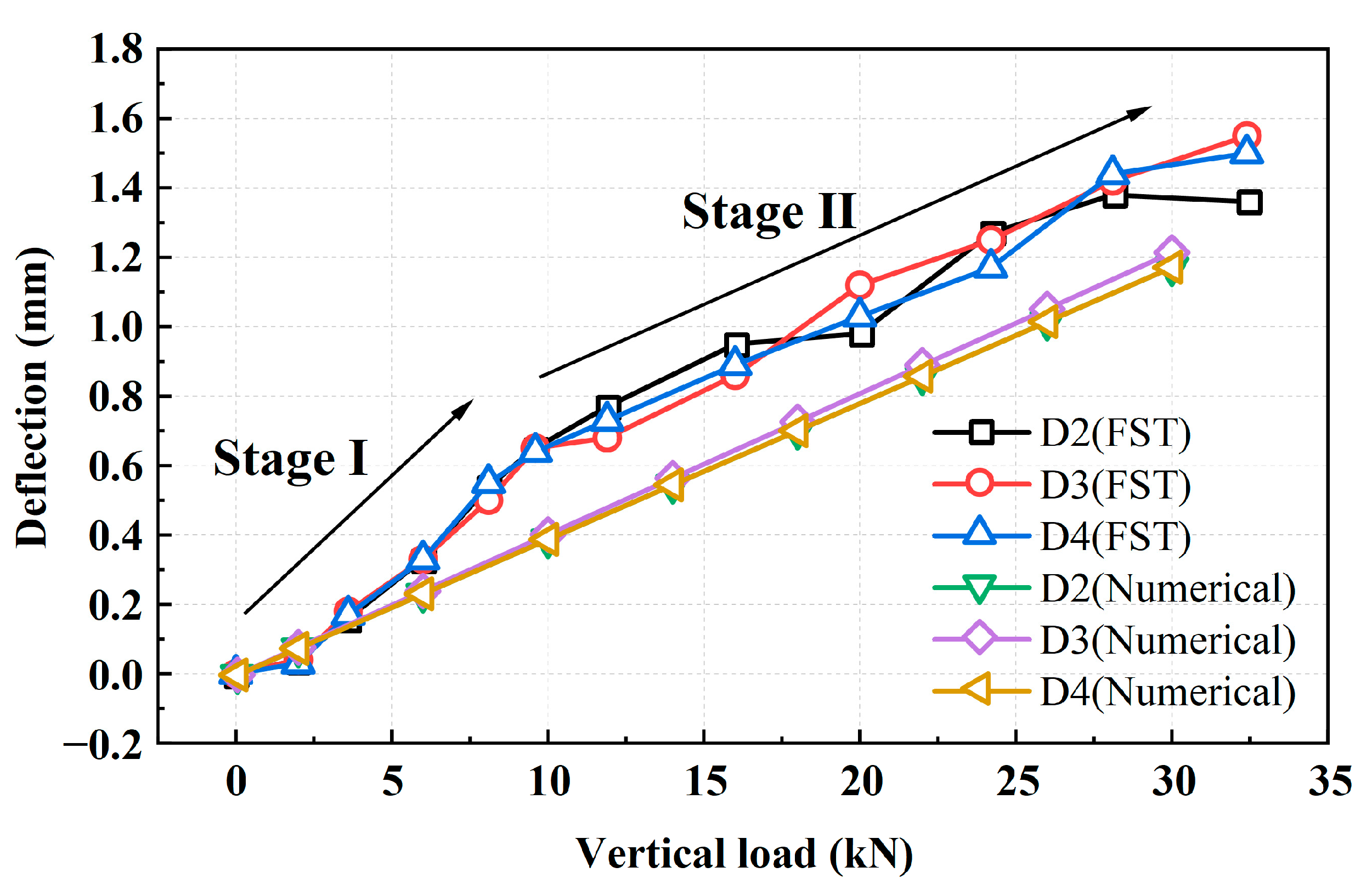
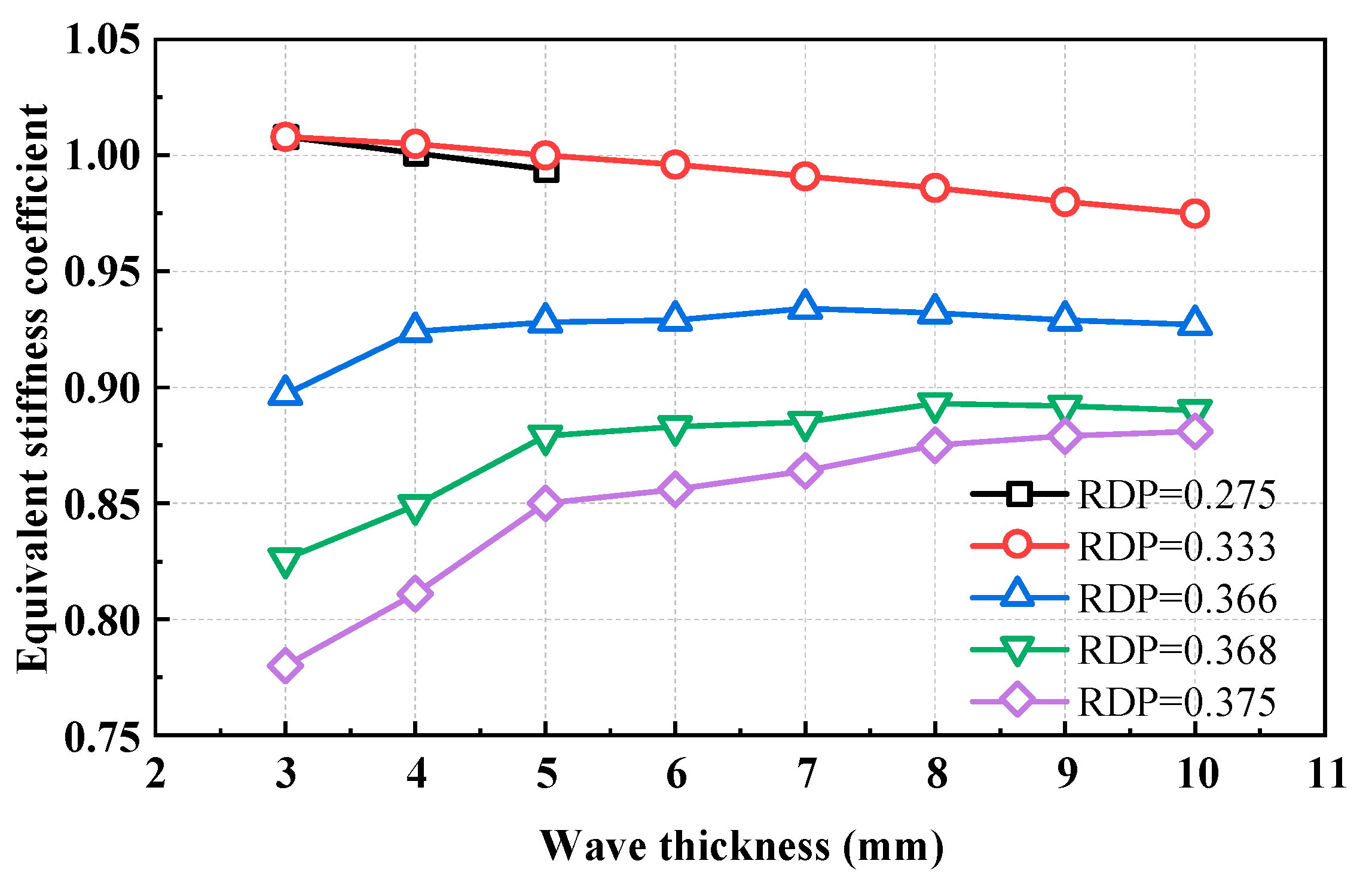
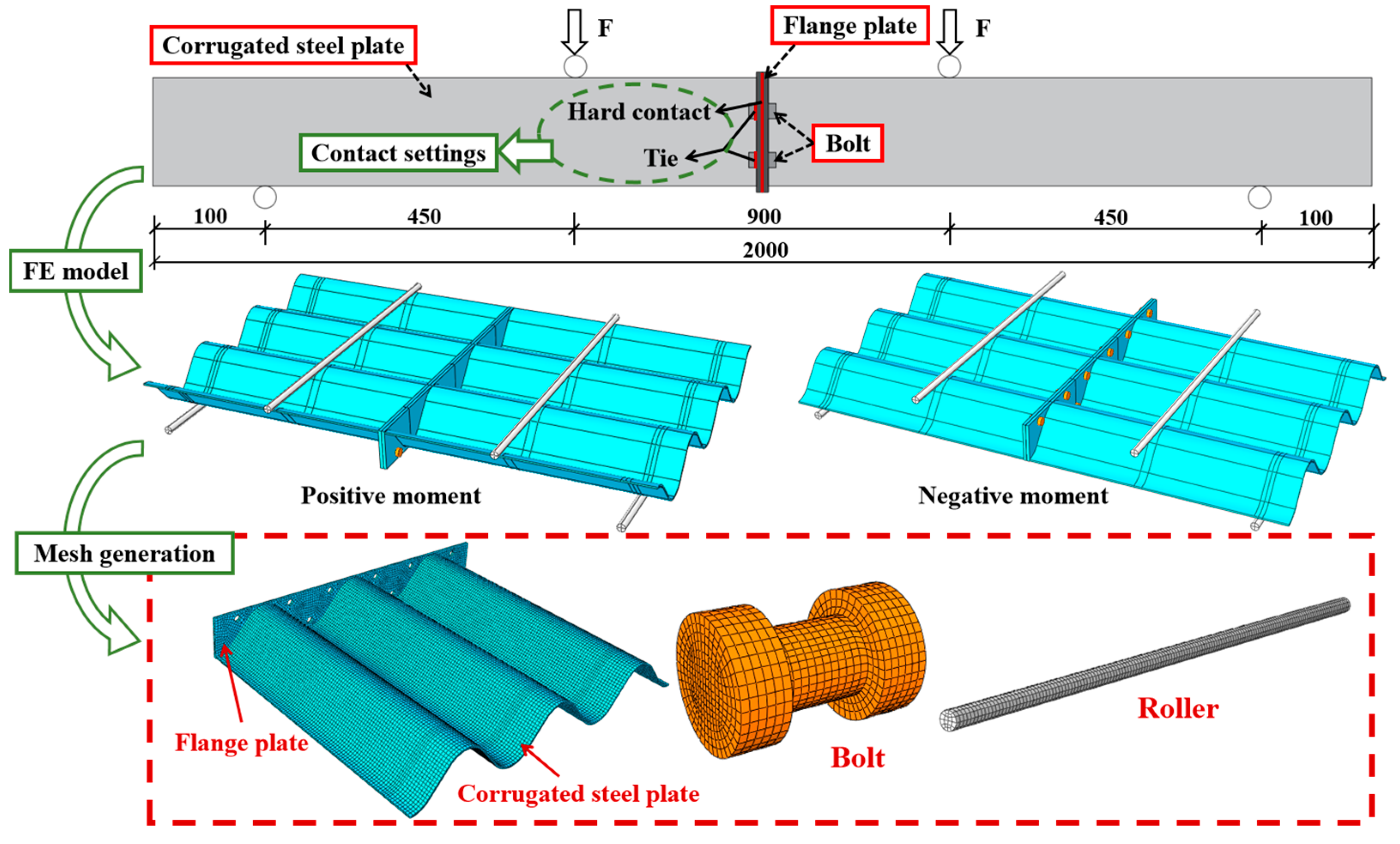
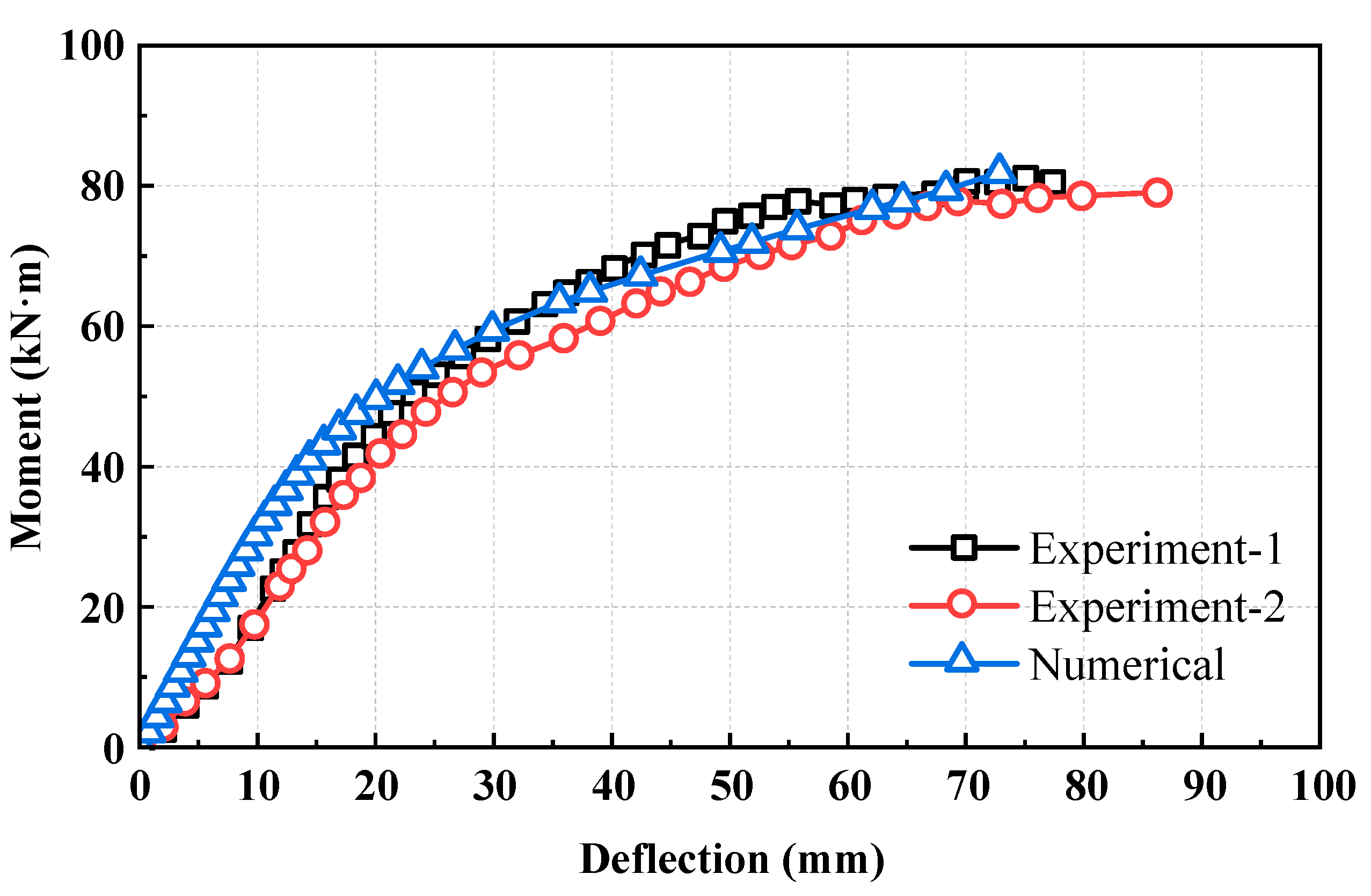

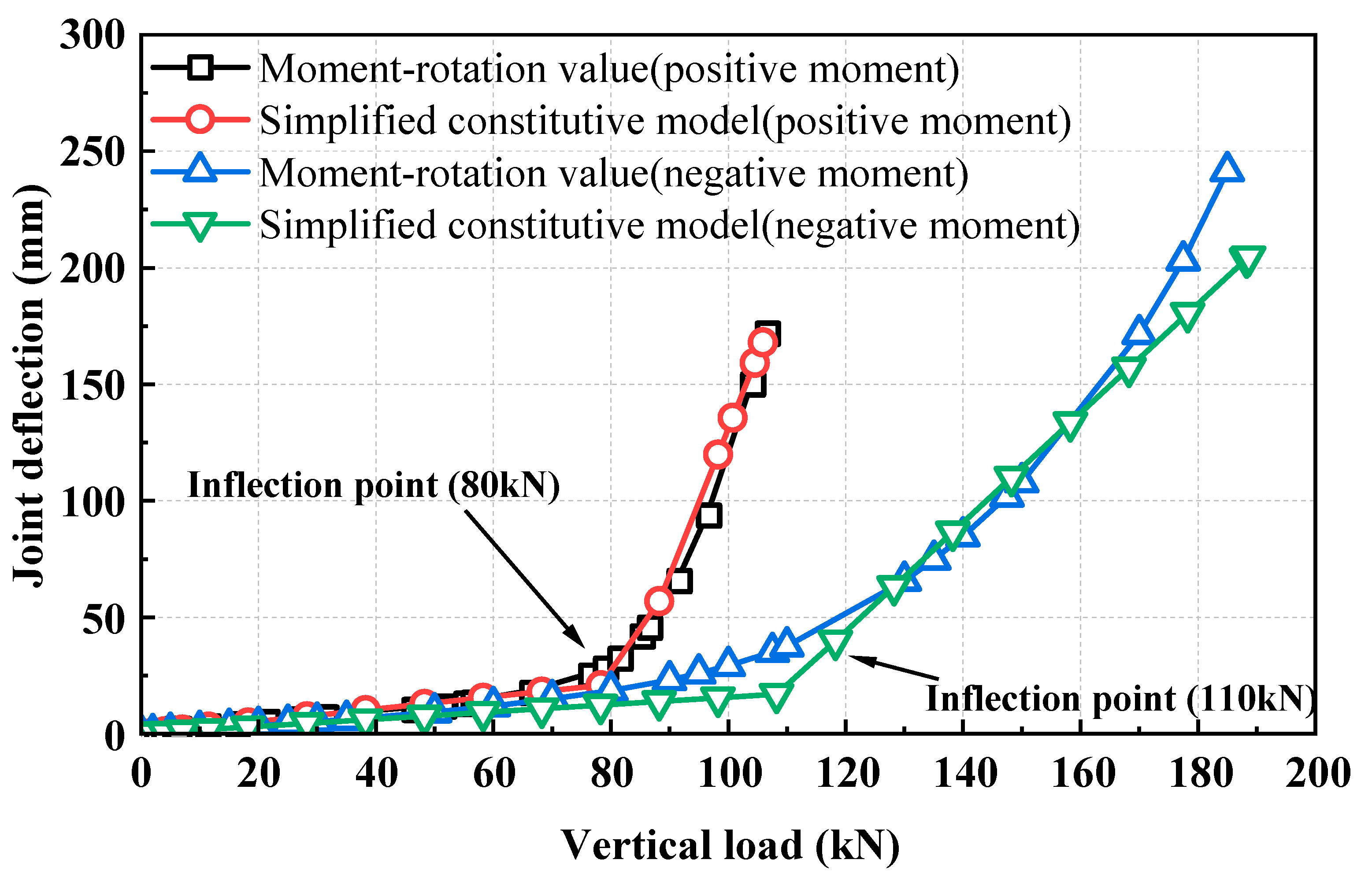


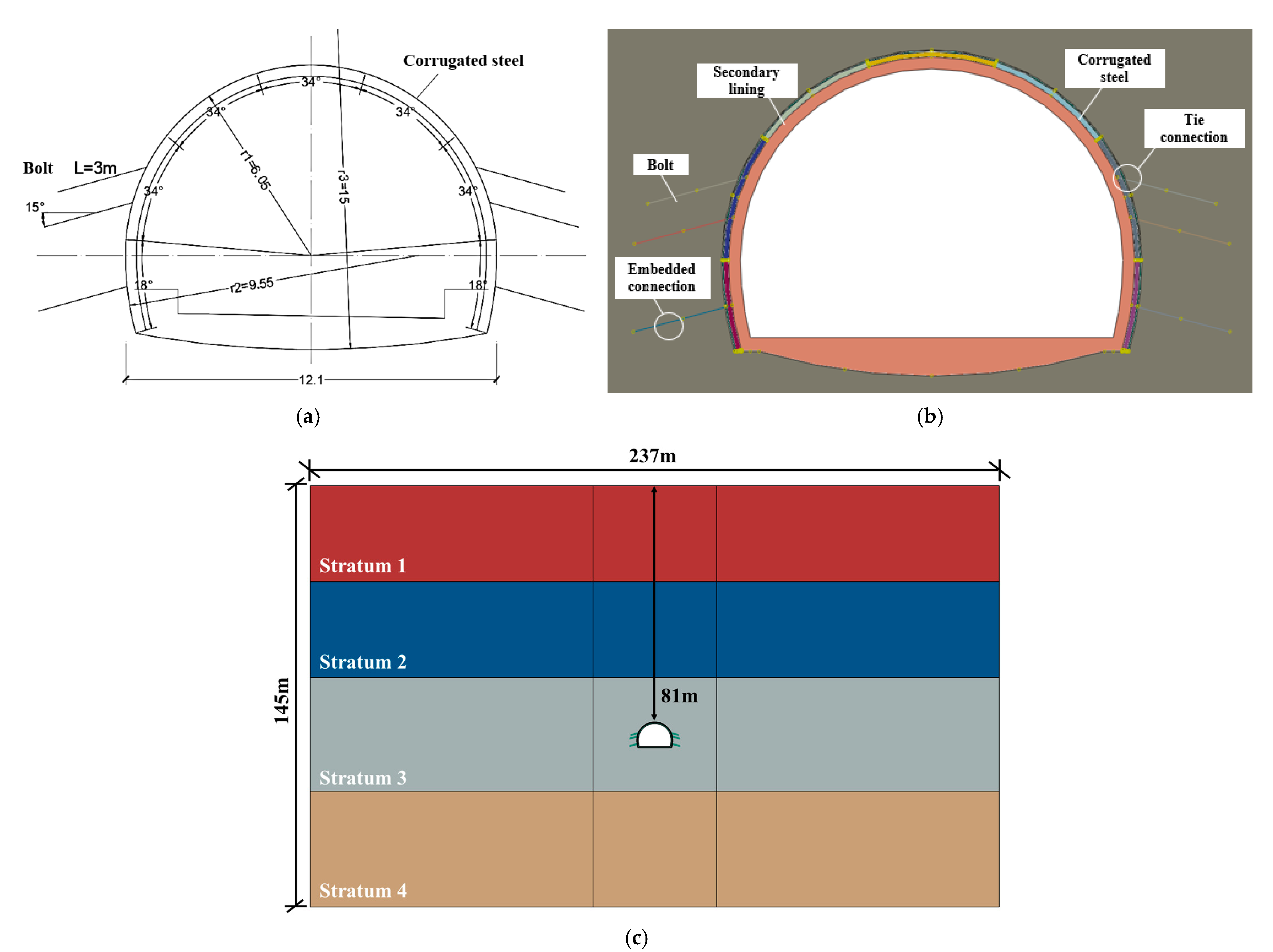
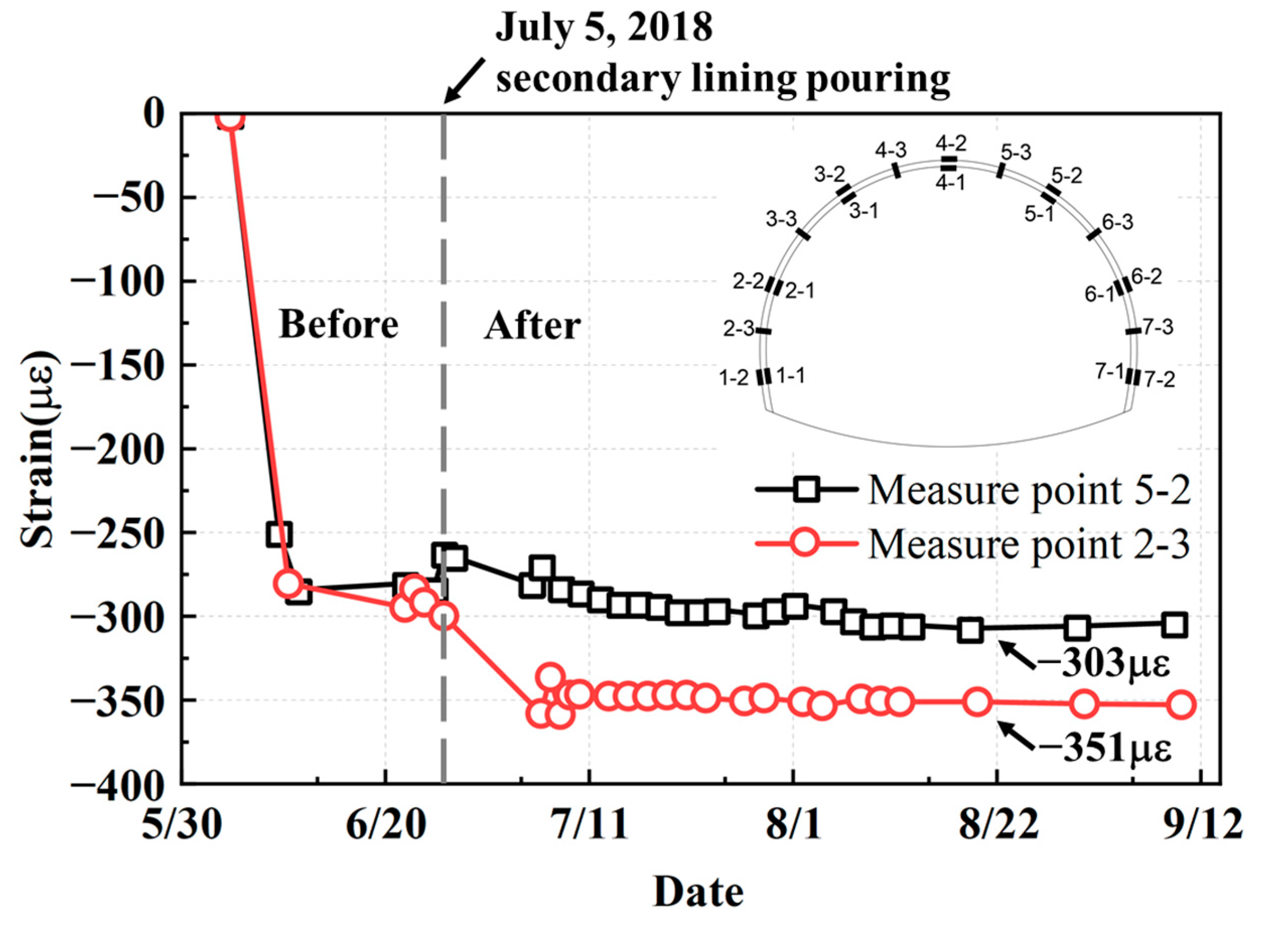

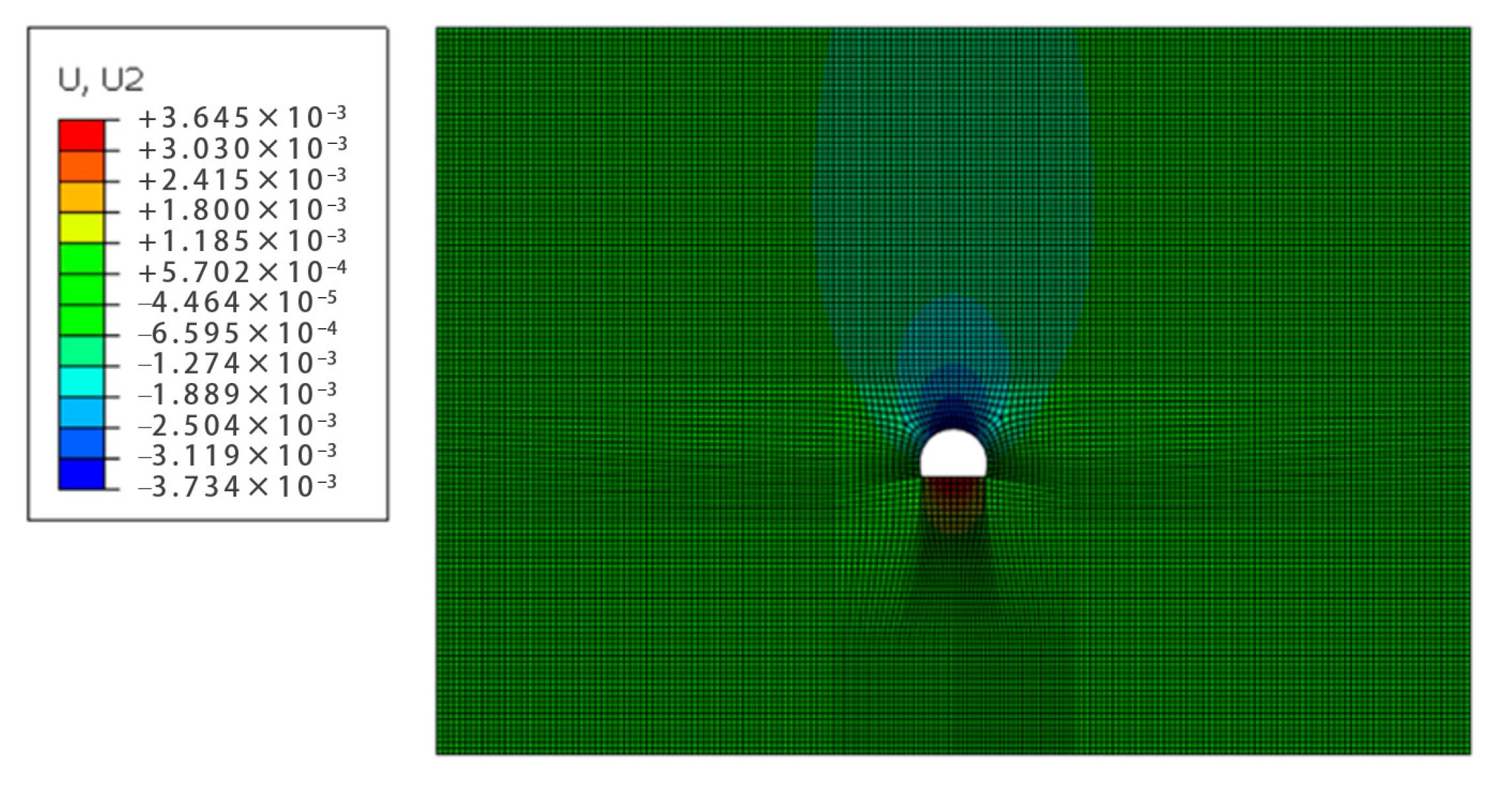
| Support | Corrugated Steel | Bolt | |||
|---|---|---|---|---|---|
| Stress/MPa | Strain/ε | Stress/MPa | Strain/ε | Stress/MPa | Strain/ε |
| 0 | 0 | 0 | 0 | 0 | 0 |
| 400 | 0.002 | 310 | 0.00155 | 640 | 0.0032 |
| 540 | 0.1532 | 440 | 0.132 | 800 | 0.1532 |
| 150-50 | 200-55 | 300-110 | 380-140 | 400-150 | |
|---|---|---|---|---|---|
| 3 | 1.008 | 1.008 | 0.897 | 0.826 | 0.780 |
| 4 | 1.001 | 1.005 | 0.924 | 0.849 | 0.811 |
| 5 | 0.994 | 1.000 | 0.928 | 0.879 | 0.850 |
| 6 | - | 0.996 | 0.929 | 0.883 | 0.856 |
| 7 | - | 0.991 | 0.934 | 0.885 | 0.864 |
| 8 | - | 0.986 | 0.932 | 0.893 | 0.875 |
| 9 | - | 0.980 | 0.929 | 0.892 | 0.879 |
| 10 | - | 0.975 | 0.927 | 0.890 | 0.881 |
| Stratum | Surrounding Rock Classification | Thickness/m | Unit Weight | Modulus of Elasticity | Poisson’s Ratio | Internal Friction Angle | Cohesion |
|---|---|---|---|---|---|---|---|
| 1 | IV | 33 | 20 kN/m3 | 1.8 GPa | 0.32 | 27° | 0.20 MPa |
| 2 | IV | 33 | 21 kN/m3 | 2.3 GPa | 0.32 | 28° | 0.30 MPa |
| 3 | IV | 39 | 22 kN/m3 | 2.8 GPa | 0.32 | 30° | 0.40 MPa |
| 4 | IV | 22 | 23 kN/m3 | 3.3 GPa | 0.32 | 32° | 0.50 MPa |
| ϴ/rad | −3 | −0.55 | −0.04 | 0 | 0.042 | 0.45 | 3 |
|---|---|---|---|---|---|---|---|
| M/kN m | −96.1 | −96.1 | −59.2 | 0 | 42.1 | 53.9 | 53.9 |
| Number of Measuring Points | Monitoring Value/με | Corresponding Value of Numerical Simulation/με | Error |
|---|---|---|---|
| 2-3 | −351 | −355 | 2% |
| 5-2 | −303 | −260 | 14% |
| Field Monitoring | Numerical Simulation | Error | |||
|---|---|---|---|---|---|
| Measuring Line | Cumulative Displacement/mm | Relative Displacement/mm | Displacement Increment/mm | ||
| After Stabilization | After Secondary Lining | ||||
| AE | 2.44 | 4.35 | 2.07 | 2.28 | 8% |
| BF | 2.41 | 2.89 | 0.98 | 1.91 | 20% |
Disclaimer/Publisher’s Note: The statements, opinions and data contained in all publications are solely those of the individual author(s) and contributor(s) and not of MDPI and/or the editor(s). MDPI and/or the editor(s) disclaim responsibility for any injury to people or property resulting from any ideas, methods, instructions or products referred to in the content. |
© 2024 by the authors. Licensee MDPI, Basel, Switzerland. This article is an open access article distributed under the terms and conditions of the Creative Commons Attribution (CC BY) license (https://creativecommons.org/licenses/by/4.0/).
Share and Cite
Ding, W.; Huang, X.; Yu, C.; Zhang, Q.; Wu, T. Calculation Method of New Assembled Corrugated Steel Initial Support Structure of Highway Tunnel. Appl. Sci. 2024, 14, 7242. https://doi.org/10.3390/app14167242
Ding W, Huang X, Yu C, Zhang Q, Wu T. Calculation Method of New Assembled Corrugated Steel Initial Support Structure of Highway Tunnel. Applied Sciences. 2024; 14(16):7242. https://doi.org/10.3390/app14167242
Chicago/Turabian StyleDing, Wenqi, Xuanbo Huang, Chengshuo Yu, Qingzhao Zhang, and Tianxiang Wu. 2024. "Calculation Method of New Assembled Corrugated Steel Initial Support Structure of Highway Tunnel" Applied Sciences 14, no. 16: 7242. https://doi.org/10.3390/app14167242





